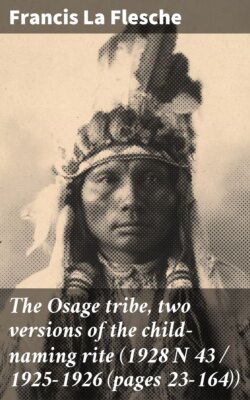Читать книгу The Osage tribe, two versions of the child-naming rite (1928 N 43 / 1925-1926 (pages 23-164)) - Francis la Flesche - Страница 11
На сайте Литреса книга снята с продажи.
Ḳi´-noN—Ceremony of Decorating the Xo´-ḳa
ОглавлениеTable of Contents
Before sunrise of the following day the Noⁿ´-hoⁿ-zhiⁿ-ga of the Puma gens assemble at the house of the member who had been appointed by the father to act as Xo´-ḳa in the ceremony. When all the members had taken their places the A´-ḳi-hoⁿ Xo´-ḳa (master of ceremonies) recites the wi´-gi-e relating to the symbolic articles with which the Xo´-ḳa is to be decorated. The wi´-gi-e is accompanied by certain ceremonial acts performed by an assistant. The first section of the wi´-gi-e relates to the red dawn, the beginning of the life of day. The assistant, who has put red paint on the palms of his hands, spreads them out toward the dawn that is reddening the eastern sky. When the A´-ḳi-hoⁿ Xo´-ḳa reaches the fourth line the assistant paints red the face of the Xo´-ḳa. Then, as the A´-ḳi-hoⁿ Xo´-ḳa goes on to the second section the assistant takes up a white, downy feather (pl. 3, b), taken from the under covert of an eagle’s tail, and holds it poised over the Xo´-ḳa’s head. When the twelfth line of the wi´-gi-e is reached the assistant quickly fastens the feather to the scalplock of the Xo´-ḳa. This feather symbolizes one of the two white shafts of light that may be seen at either side of the sun as it rises through the fading color of the dawn. Each of these two shafts symbolizes a never-ending life. The one at the right belongs to the Hoⁿ´-ga great division and the one at the left to the Ṭsi´-zhu great division. At the beginning of the third section of the wi´-gi-e the assistant rubs in the palms of his hands a bit of buffalo fat, then holds his outspread hands poised over the Xo´-ḳa’s head. When the twentieth line is reached he anoints the Xo´-ḳa’s hair with the oil, an act by which is expressed the wish that the child whom the Xo´-ḳa represents shall always be abundantly supplied with food of all kinds.
At the fourth section of the wi´-gi-e the assistant takes up a necklace of beads, or a narrow woven band, to which is attached a shell gorget (pl. 3, a) and holds it in readiness. When the twenty-sixth line is reached he puts the necklace upon the neck of the Xo´-ḳa so that the gorget hangs upon his breast. This gorget typifies the Sun, whose life endures forever.
